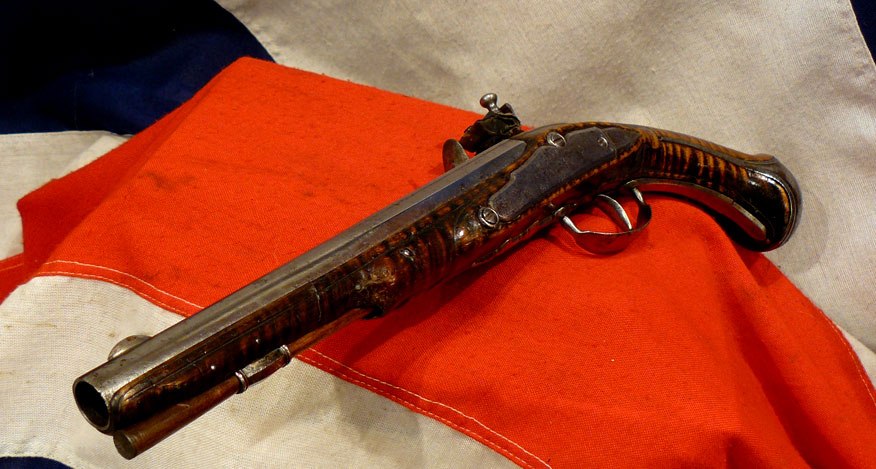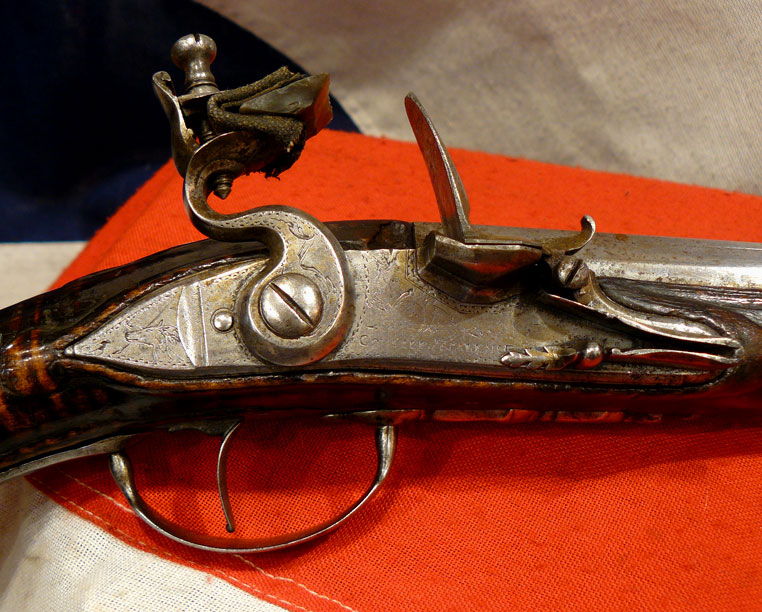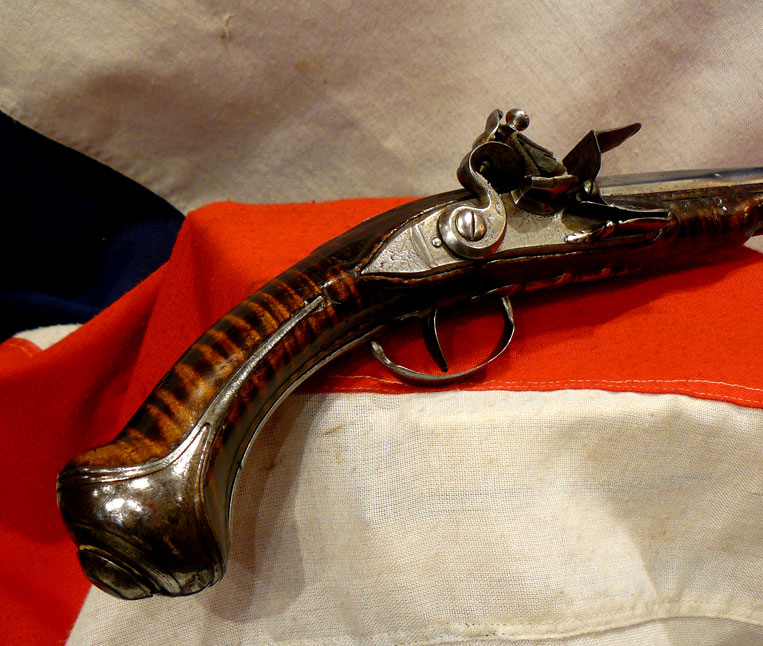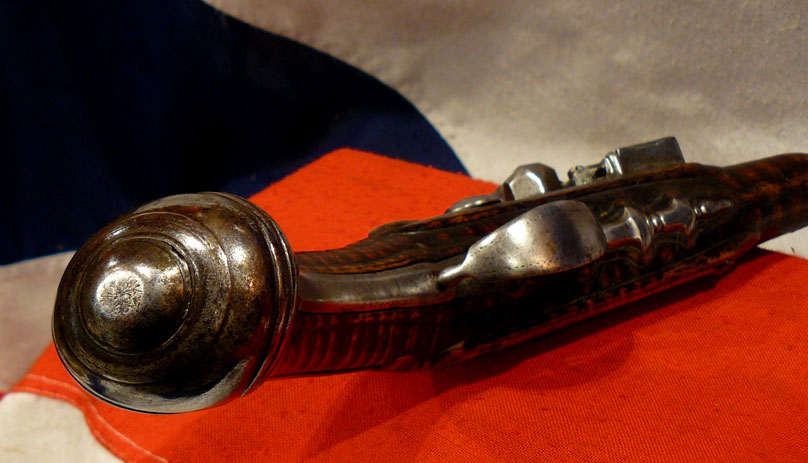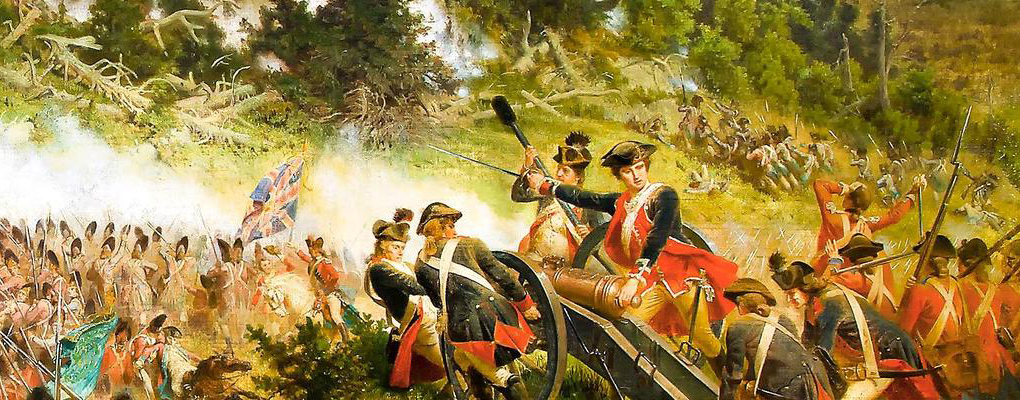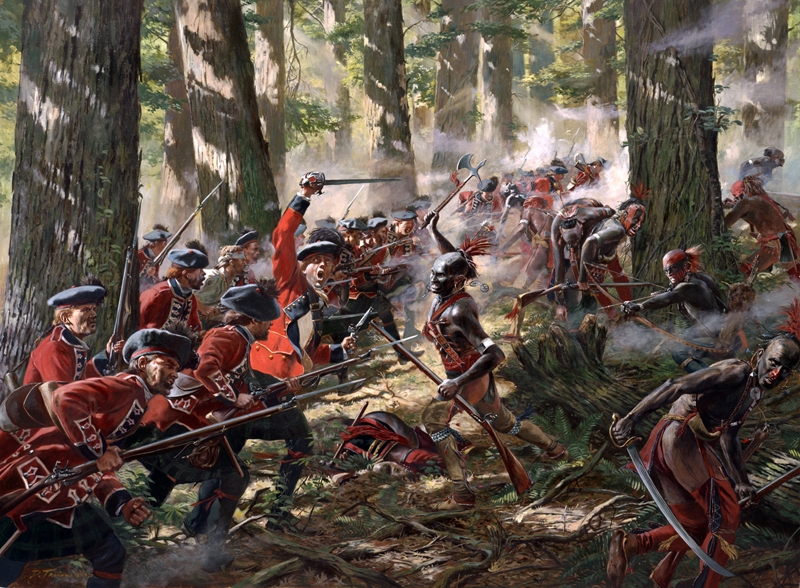A Most Fine and Beautiful 18th Century French Flintlock Circa 1740. A Superb Flintlock Much Favoured By Pirate, Privateer, Buccaneer & Corsair Captain's, From The Mid 18th Century to The Napoleonic Wars Era. Finest 'Tiger Stripe' Maple Stock
With a very fine and stunning looking tiger stripe maple wooden stock, bearing a simply superb natural age patina. Signed lock and all steel mounts. In jolly nice condition.
Long eared buttcap typical of the 1740's period flintlocks that saw service by pirate and corsair captain's fleets, from the the Anglo French Seven Years War in Europe and America where they raided ships of both sides the French and British supply galleons. And a finest pistol that would see continual use right through the Napoleonic Wars.
The French and Indian War (1754-63) comprised the North American theater of the worldwide Seven Years' War of 1756-63. It pitted the colonies of British America against those of New France.
Both sides were supported by military units from their parent countries, as well as by American Indian allies. At the start of the war, the French North American colonies had a population of roughly 60,000 settlers, compared with 2 million in the British North American colonies. The outnumbered French particularly depended on the Indians. The European nations declared war on one another in 1756 following months of localized conflict, escalating the war from a regional affair into an intercontinental conflict.
In the 1760s, corsairs were primarily privateers operating under a letter of marque, authorized by a state to attack enemy shipping. While often romanticized, they were essentially state-sanctioned pirates, with the potential for both profit and a degree of legitimacy. The most prominent corsairs in the 1760s were likely the Barbary corsairs, who operated out of North Africa, and French corsairs, who were active in the Mediterranean and Atlantic.
Corsairs, unlike pirates, were granted legal authority by a state, typically through a "letter of marque". This document authorized them to attack ships of enemy nations and seize their cargo, with the understanding that the spoils would be divided between the corsair and the state.
The Barbary corsairs, based in North Africa (Barbary Coast), were a significant force in the 1760s. They operated under the loose authority of the Ottoman Empire and preyed on shipping in the Mediterranean, often demanding tribute for safe passage.
French corsairs were also active in the 1760s, particularly during periods of conflict with other European powers. They aimed to disrupt enemy trade and supplement French naval power through privateering.
Corsairing was a risky but potentially lucrative business. While they could amass wealth through captured prizes, they also faced the dangers of capture by enemy navies and the possibility of being treated as pirates (if their letters of marque were not in order or if they engaged in activities beyond their authorization
Corsairs had a significant impact on maritime trade and naval warfare in the 1760s. They disrupted shipping lanes, contributed to naval conflicts, and played a role in the economic and political landscape of the time.
More than 20,000 captives were said to be imprisoned in Algiers alone. The rich were often able to secure release through ransom,
The name French and Indian War is used mainly in the United States. It refers to the two enemies of the British colonists, the royal French forces and their various American Indian allies. The British colonists were supported at various times by the Iroquois, Catawba, and Cherokee, and the French colonists were supported by Wabanaki Confederacy members Abenaki and Mi'kmaq, and Algonquin, Lenape, Ojibwa, Ottawa, Shawnee, and Wyandot.
British and other European historians use the term the Seven Years' War, as do English-speaking Canadians.
No consensus exists as to when the French Revolutionary Wars ended and the Napoleonic Wars began. Possible dates include 9 November 1799, when Bonaparte seized power on 18 Brumaire, the date according to the Republican Calendar then in use;41 18 May 1803, when Britain and France ended the one short period of peace between 1792 and 1814; or 2 December 1804, when Bonaparte crowned himself Emperor.42
British historians occasionally refer to the nearly continuous period of warfare from 1792 to 1815 as the Great French War, or as the final phase of the Anglo-French Second Hundred Years' War, spanning the period 1689 to 1815.43 Historian Mike Rapport (2013) suggested using the term "French Wars" to unambiguously describe the entire period from 1792 to 1815.44
In France, the Napoleonic Wars are generally integrated with the French Revolutionary Wars: Les guerres de la Révolution et de l'Empire.
It is often the case, as is here, that some descended nobility of France often fought on the side of the revolutionaries and then under Napoleon, and used their predecessors weapons, as little changed in the efficiency of pistols from the 1740’s to the 1790’s or even the 1810’s, so older style pistols had a remarkably useful life for up to 80 years or even more, especially for senior officers serving under Bonaparte.
As with all our antique guns no license is required as they are all unrestricted antique collectables
Code: 21456
2345.00 GBP


